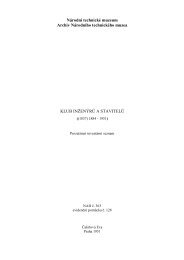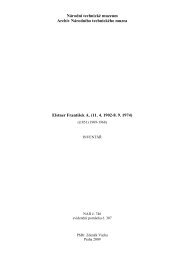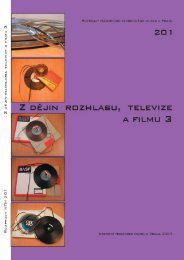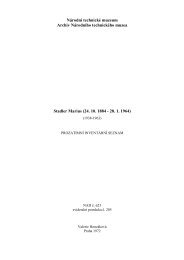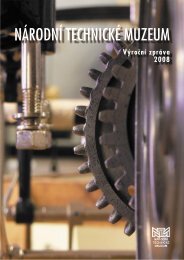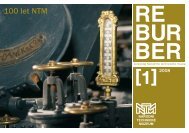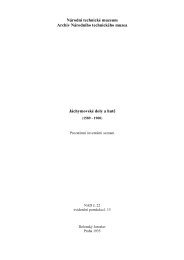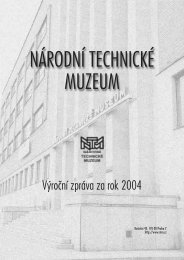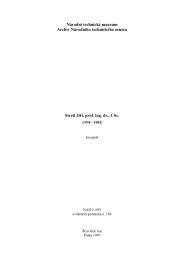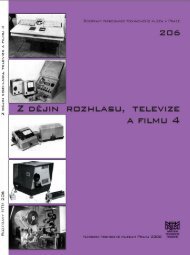13. National Technical Museum – Annual Report <strong>2006</strong>ForewordDear Readers of the National Technical Museum’s Annual Report,<strong>2006</strong> brought a number of events significantly affecting NTM activity, both positively and negatively.Perhaps the most important event was renewal of building works on partial reconstruction of the main building - stage II. The total extent of the building works necessitated clearance of allthe offices on the 3 rd floor and provisional relocation of the staff to the north-west wing. The building was completely closed to the public in September <strong>2006</strong> in view of the building worksthat were going on.In May <strong>2006</strong>, after successful building use approval procedure, a new depository hall was brought into operation on the Čelákovice site and by the end of the year hundreds of collectionitems had been successfully transported and stored there.Although the reconstruction of the main building and also transport of collections to the new depository already in essence give great cause for optimism, work in connection with it is mostlymanual and requires little specialist expertise, and is often physically demanding. For this reason we have to thank in particular all those who worked with us, who carried out such a thanklessand not very satisfying task.Even in this situation we were able to achieve a number of excellent results; of all these I will mention, for instance, completion of restoration work on a Krajánek aeroplane and on the railcar Komarek and starting project work on the first two new permanent exhibitions – polygraphy and architecture.Building AlterationsMain buildingIn May 2001, the Ministry of Culture of the Czech Republic allocated a capital investment grant of CZK 85 million for this purpose. The basic part of all the project work was completed in2002. At the beginning of 2003, a comprehensive implementing project was completed and building permission was granted. Průmstav a.s., which was selected on the basis of an openpublic tender, began construction work at the end of May.In April 2004, the Ministry of Culture of the Czech Republic stopped financing the work, but at the beginning of 2005 the Ministry decided to continue the reconstruction of the main buildingof the NTM and to allocate funds totalling CZK 192 million. In 2005, a new project was prepared including other areas as well as completion of the parts of the building where work had notbeen completed; renovation would now proceed in ca 70 % of the whole building. During the year a new building contractor was selected in an open public tender, OHLŽS a.s., and buildingworks were re-started at the end of 2005 and the beginning of <strong>2006</strong>. During <strong>2006</strong>, first and foremost work was completed on the partially built areas in the north-west wing, the 1 st floorwith an air-conditioned archive depository, and the offices on the 2 nd and 3 rd floors. These areas obtained building use approval in the 2 nd quarter of the year. Building also continued in theremaining areas of the building, on six floors in all. In September <strong>2006</strong>, building work was extended to the entrance hall area on the ground floor and there was no alternative but to closethe building to visitors. In the reconstruction, premises are being constructed for new exhibitions of architecture, polygraphy, astronomy, telecommunications, technology in people’s everydaylives, two exhibition halls, a cinema hall, a conference room, restaurant, shop and cloakroom areas, more than forty new offices for staff, a car park for visitors and other facilities. Completionof the reconstruction is planned at the end of 2007 and the beginning of 2008.New depository in ČelákoviceIn April <strong>2006</strong>, the National Technical Museum brought into operation its new depository on its warehouse site in Čelákovice. This building, which was erected at a cost of CZK 85 millioncrowns, has a rectangular ground plan measuring 60 x 40 m. The basic condition for the internal layout of the depository that we assigned to the designers was for it to be multi-functional.This condition arises from the structure of the Museum’s collection stock, which is somewhat different from that of other museums. For in addition to items of normal size, the collections alsocontain hundreds of bulky and heavy machines and vehicles and large models of constructions and manufacturing equipment.The depository is in principle divided into a reception section, which includes the preservation workshops, and a storage section, a depository. Both sections are strictly separate in order toprovide protection against the possible spread of harmful microorganisms.CollectionsIn the introductions to annual reports over the past few years reference has been made in the collections section to the Museum’s atypical situation, namely the need to eliminate the resultsof the floods which affected part of the collection stock in 2002, and to deal in all aspects with the massive movements of collections resulting from the ongoing reconstruction of the mainbuilding of the Museum. These restrictions, requiring tasks to be dealt with more at the operating level and limiting conceptual work concerning collections, persisted in <strong>2006</strong> too, but inone respect there was a new development which, together with other effects, will gradually improve the unfavourable situation. This was the bringing into operation of a new and moderndepository in Čelákovice, meeting all the demands for modern treatment of the collection stock. Moving the treated collections to these premises and ongoing preparation of collections fornew exhibitions in the reconstructed areas of the Museum alongside this were our main activities in the past year.Preservation and restoration of collection itemsA vast amount of external restoration work was financed from the Ministry of Culture of the Czech Republic’s special flood fund (elimination of the results of the catastrophic floods whichhit Prague in the summer of 2002 and did disastrous damage to the Museum’s collection stock), particularly in the mechanical engineering and electrical engineering collections. 12 itemsin the mechanical engineering collection were repaired (3 items from the power drive machines collection, 1 from technology in the home and 8 from the textiles collection; a model of atwin-cylinder steam engine, a model of a single-cylinder steam engine, a wall steamer, a Scando electric washing machine, a Maxim knitting machine, a winding frame, a J.J. Rieter rovingframe, a model of a printing machine, a device for engraving printing machine rollers, a Laeserson & Wilke weaving loom, a carpet weaving loom and a hosiery frame). 22 items fromthe electrical engineering collection were restored (17 arc lamps, two Hughes telegraphs, radio engineering equipment from the First World War and two rotating electrical machines). Inaddition, a total of 7 plaster, 4 plastic and 7 wooden collection items were restored from the architecture and construction industry collection (created by F. Roith, F. A. Libra, P. Janák, SIAL- K. Hubáček et al., and others) and a collection of 20 models of statues of artists and scientists from the attic gable of the Rudolfinum produced by various artists in the second half of the19 th century. Also 27 plan scrolls with one sketch book, 433 plans and 20 drawings (Barvitius, Fanta, Gočár, Kotěra, Janák, Rössler, Sander, Schulz, Zítek) and a collection of 19 historicaladvertising posters of Czech, French and Belgian origin from 1890 to 1914 were renovated and preserved. In the Museum’s library a set of 12 old prints and books were restored and 287damaged books and magazines were rebound.44
In addition, the following external items of restoration and preservation work were commenced, were in progress or were completed: Commencement of work on an Aero C-104 aeroplane,completion of work on a Zlín Z-25 Krajánek aeroplane, completion of restoration and bringing into working order of the steam vehicle M 124.001 KOMAREK.Drying of frozen archive materialAlso in <strong>2006</strong> we have been constantly grappling with the results of the floods in 2002. The records that were inundated at that time and frozen are continually being thawed out and dried. In<strong>2006</strong>, 20m 3 of frozen material were processed in the Museum’s specialised work premises (the section for drying frozen records) and two cubic metres were freeze-dried in a chamber in theNational Archive. We can, for instance, mention here the drying of 200 archive boxes and 72 plan chests from the architecture and construction industry collections and 45 boxes of recordsand 470 drawings from the NTM Archive collection stock. At 31 December <strong>2006</strong>, 124 cubic metres of frozen documents remained from the floods in 2002.Important acquisitions in the Museum’s collection stockMotorcycle Motor Company 1000 SV 1924Collection: Transport/MotorcyclesOne of the long line of forgotten motorcycle producers in our history is the Prague firm with the English name Motor Company. The founder of this firm was Vladimír Gut, a man who isknown mainly as the importer of Bugatti cars, which he started to import later. At the beginning of the 1920s, his company was engaged mainly in the repair of motorcycles, cars and theirbodies. From 1924, it also produced motorcycles for a short time. In the cramped premises of the firm, which was based at Vinařská 16, Prague – Letná, ie approximately 200 metres fromthe present National Technical Museum building, two entirely different types of motorcycle were created in a very short time.The first machine came out as early as 1924. Two Motor Company 1000 SV motorcycles have been preserved to the present day. One of these is in a private collection in Bohemia. The otherMotor Company 1000 SV machine, which thanks to its owner was preserved in practically original and well preserved condition (the only important changes are modernised wheels and brakes– the motorcycle should have welted tyres and rim brakes), became part of the Museum’s collection.Prototype of a Jawa 500 824 “Boxer” motorcycleCollection: Transport/MotorcyclesMotorcycle from 1984, prototype, of which ten were made. The new Jawa engine concept was protected by Czechoslovak designer’s patent no. 184898 of our designers ing. V. Šantora, V.Bezoušek and ing. J. Kubínek and also similar patents abroad.Transmission gearing is divided into three main parts: primary transmission by gear wheels, with the clutch placed in the front part of the engine; gearbox placed under the engine andsecondary transmission by a cardan shaft, supplemented by an interchangeable pair of gear wheels.The whole design of the machine was the work of Výzkumně vývojový závod n. p. Jawa (Jawa Research and Development Works National Enterprise) and in addition to the designer’s patentreferred to above was also protected by other designer’s patents nos. 212952, 201233, 198716, 192893 and 192167.The motorcycle chassis was designed with production links to similar types of two-stroke Jawa motorcycles.PropellerCollection: Transport/AviationThis propeller together with a Škoda Hs 8Fb engine with an output of 300 horse power formed part of the propulsion unit of the single-seater BH-21 fighter plane, produced in the Avia factoryin Prague. A prototype of the BH-21 made its first flight on 24 February 1925. The Czechoslovak armed forces started to purchase these highly manoeuvrable and easily controlled fightersfrom June 1925. Mass production from 1925 to 1928 enabled wide-scale rearming of fighter squadrons of the air force that was being built up with a domestic type of aircraft.A total of 139 aircraft of this type were made. This Avia BH-21 was also one of the few made under licence by the Belgian firm SABCA; it produced about 50 of these machines.With its flight features and capabilities this aircraft played a key role in the development of Czechoslovak air aerobatics and its arrival on the European scene. Pilots with highly reputablenames such as the first Czech air aerobatics champion, Staff Captain František Malkovský, and later also the most successful Czechoslovak acrobat, František Novák, chose the aircraft fortheir public performancesCurrently, no other known fragments or parts of Avia BH-21 aircraft equipment are extant. The propeller can be said to have high representative value, in that it is a component of the timeof a very important aircraft made in this country.Roam multi-wheel trailor CullemayerCollection: Railway MuseumA road multi-wheel trailer of the Cullemayer system was earmarked for transport of rail cars by a towing vehicle. This is a version produced by LOWA Waggonbau Gotha VEB in the formerGerman Democratic Republic around 1950 following the original pre-war documentation from Cullemayer. The multi-wheel trailer was used for transport of complete car consignments fromthe railway station to the final recipient by road. Similar transport systems were widely used here, but with the development of road freight transport they gradually died out.StoveCollection: Cast-iron art workWholly cast-iron stove in the Neo-Gothic style from the second half of the 19 th century. The stove is not signed and the maker is not known. It was purchased in Prague, but we have notbeen able to ascertain where it was used.The stove is like a similar type of stove with a similar eight-sided base, which was made in the Mariazell foundry in Austria.MangleCollection: Household TechnologyThis manual wooden roller mangle with screw adjustment of the roller pressure was made in the second half of the 19 th century. The mangle has manual propulsion by means of a handlewith a metal cogwheel, is decorated with wood carvings, and at the top of both side plates is carved the inscription: IFJ. CZEILER ISTVÁN, SZABADALOM - PATENT. The dimensions of the mangleare 700 x 630 x 1000 mm. This is one of the first types of all-wood twin-roller mangles made in Eastern Europe.45



